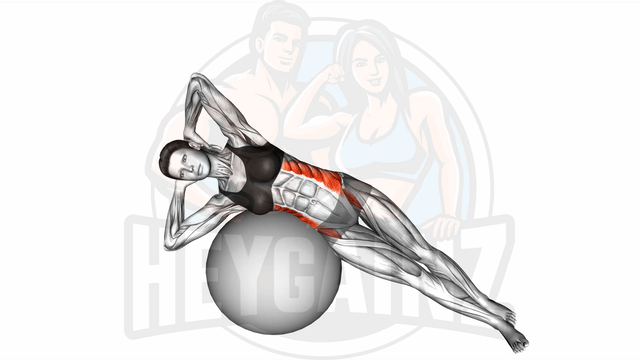
Instructions:
- 1Sit sideways on the stability ball with your feet flat on the floor
- 2While keeping your back straight, slowly bend at the waist to the side, lowering your torso as far as comfortable
- 3Pause for a second when you reach the farthest point of your bend
- 4Slowly return to the starting position by pushing your torso back up
- 5Repeat the exercise on the other side
Tips:
- Keep your movements slow and controlled to engage the oblique muscles more effectively
- Make sure not to overreach as it can cause strain
- Focus on your oblique muscle as you pull your body back up, not just when you’re lowering it
- Breathe in as you bend and breathe out as you return to the starting position
Mastering the Side Bend: A Comprehensive Guide
The side bend is an excellent exercise targeting the oblique muscles, providing numerous benefits for those looking to strengthen their waist and enhance core stability. Often performed with a stability ball, this movement not only engages the side muscles but also improves overall flexibility and stability. Additionally, variations like the side bend stretch or the side bends exercise can further enhance the workout experience.
Muscles Worked
During the side bend, the primary muscles engaged are the obliques, located on the sides of the torso. These muscles play a crucial role in rotating and bending the body sideways. Incorporating side bends into your routine can help build strength in these areas, making them more resilient to injury and improving overall athletic performance.
Benefits of the Side Bend
- Improved Core Strength: Side bends enhance the stability and strength of the core, crucial for a robust physique.
- Flexibility: Regular practice can lead to increased flexibility in the waist and oblique muscles.
- Injury Prevention: Strengthening the obliques can help in preventing injuries, particularly for those involved in sports like golf where side bending is common.
- Enhanced Athletic Performance: Improved core strength and flexibility can significantly benefit overall performance in sports and physical activities.
Tips for Performing Side Bends
To make the most of your side bend exercise, consider the following tips:
- Posture: Maintain a neutral spine throughout the movement to prevent strain on the back.
- Controlled Movement: Focus on making the movement slow and controlled to fully engage the oblique muscles.
- Breathing: Inhale as you prepare to bend, and exhale as you move into the side bend for better oxygen flow and muscle engagement.
- Engage Your Core: Keep the core engaged during the exercise to maximize its effectiveness and aid in stability.
Whether you're incorporating this into a yoga pose or a pilates routine, the side bend is a versatile exercise that can be modified to suit all fitness levels. Embrace the numerous side bends benefits and make this valuable addition to your workout regimen. With consistent practice, you’ll undoubtedly notice improvements in strength, flexibility, and overall core stability.